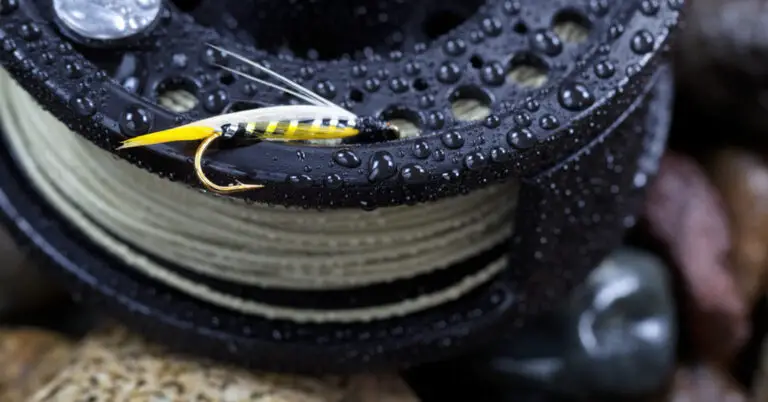What Is the Thinnest Fishing Line? Unraveling the Secrets of Ultra-Thin Fishing Lines
Imagine standing by a serene lake at the crack of dawn, fishing rod in hand, casting your line into the shimmering water. There’s an extraordinary element at play here that often goes unnoticed yet plays a crucial role in the success of your angling adventure. It’s not the bait or the hook but the connecting thread between you and the aquatic world below.
The thinnest fishing lines are often fluorocarbon or monofilament lines with low pound test ratings. For example, Berkley’s Trilene XL Smooth Casting Line offers a 1-pound test line with a diameter of just 0.002 inches (0.00508 cm), making it one of the thinnest lines available.
This element of near-invisibility, a whisper-thin tether, works in silence, creating a delicate balance between you, the hopeful angler, and the elusive fish. Welcome to the fascinating realm where the almost imperceptible meets the undeniably significant.
Defining Ultra-Thin: The Thinnest Fishing Lines

We’re delving into lines with very small diameters when we talk about ultra-thin fishing lines. These are lines that, while thin enough to be nearly invisible in water, still need to possess the strength and durability to withstand the tension and stress associated with catching fish.
So, what constitutes an ultra-thin line? Though there’s no definitive standard, lines with diameters less than or around 0.005 inches (or 0.127 millimeters) are often called ultra-thin. Some manufacturers produce thinner lines, reaching as low as 0.002 inches (0.00508 cm) in diameter for certain types.
The realm of the thinnest fishing lines is occupied predominantly by fluorocarbon and monofilament lines, with Berkley’s Trilene XL Smooth Casting Line (Amazon) being a prime example, offering a 1-pound test line at a minuscule 0.002 inch (0.00508 cm) diameter.
Fluorocarbon lines are favored in this ultra-thin category due to their unique properties: they’re nearly invisible underwater, resistant to UV light, and less susceptible to abrasion than their counterparts.
Monofilament lines, on the other hand, offer a blend of low visibility, ease of use, and affordability. Despite their thin diameter, these lines are engineered to provide sufficient strength for an exciting and successful angling experience.
Types of Fishing Lines: Monofilament, Fluorocarbon, and Beyond
When choosing a fishing line, you’ll find yourself at a crossroads between various types, each boasting unique attributes. Monofilament, fluorocarbon, and braided lines are the most commonly used, though others like copolymer and fly lines also find their place in the angler’s toolkit. Understanding these different types is key to selecting the right line for your angling needs.
- Monofilament: This is the most popular type of fishing line made of a single strand of material, typically nylon. It’s easy to handle, knot, and cast, making it suitable for beginners and all-around fishing. While it’s available in various strengths and diameters, including ultra-thin options, it tends to have more stretch and less sensitivity than other line types.
- Fluorocarbon: This line type is denser and less visible underwater than monofilament, making it a preferred choice for clear water and wary fish. Fluorocarbon lines have high abrasion resistance and less stretch, translating into better sensitivity. They’re often used as leaders due to their near-invisibility, but ultra-thin versions are also used as main lines.
- Braided: Braided lines are made of multiple strands of material woven together, resulting in a strong, durable line with high knot strength. They offer excellent castability and sensitivity but lack the invisibility of fluorocarbon and monofilament lines. Braided lines aren’t typically available in ultra-thin diameters.
- Copolymer: This is essentially a variant of monofilament made by combining two types of nylon. Copolymer lines are more abrasion-resistant and stretch less than regular monofilament, making them suitable for various fishing situations.
- Fly Lines: These are specialized lines designed for fly fishing. They’re typically heavier and thicker than other lines and are used to precisely deliver lightweight flies. Fly lines come in various weights, tapers, and designs to match different fly fishing scenarios.
Factors Influencing the Diameter of Fishing Lines

Several factors come into play when determining the diameter of fishing lines, each significantly impacting the line’s performance and suitability for specific angling conditions.
- Material: The base material used in the line’s construction significantly affects its diameter. Monofilament lines, for example, are typically made from a single strand of nylon, which has a larger diameter than other materials. Fluorocarbon lines, on the other hand, offer a smaller diameter with similar strength due to their denser composition.
- Line Strength or Pound Test: The pound test, or the line’s breaking strength, directly influences its diameter. Higher-pound test lines are thicker, requiring more material to withstand greater force. Conversely, lower-pound test lines are thinner and designed to handle less weight before breaking.
- Manufacturing Process: The method used to create the fishing line can also impact its diameter. Braided lines, for instance, involve intertwining several strands of material, resulting in a thicker line. Some manufacturers also employ proprietary techniques to reduce the diameter without compromising strength.
- Additional Coatings or Treatments: Some lines are coated or treated to enhance specific properties, such as resistance to UV light, water absorption, or abrasion. These coatings may increase the diameter of the line.
- Line Type: Different types of lines inherently have different diameters. For example, fly fishing lines, designed to deliver lightweight flies, are generally thicker to provide the necessary weight for casting. Monofilament and fluorocarbon lines, on the other hand, are typically available in thinner diameters.
Pros and Cons of Ultra-Thin Fishing Lines
Ultra-thin fishing lines have carved out a niche in the angling world, offering unique advantages and challenges that distinguish them from their thicker counterparts. Their stealthy presence and lower drag are appealing, but they also come with certain caveats, such as lower strength and higher susceptibility to damage. Understanding these pros and cons can inform a strategic decision based on your fishing needs and conditions.
Pros of Ultra-Thin Fishing Lines:
- Stealth: Ultra-thin lines are nearly invisible underwater, making them ideal for clear water conditions or targeting wary fish species easily spooked by more visible lines.
- Reduced Drag: Thin lines encounter less resistance or drag in the water, which can increase casting distance and improve lure action.
- Sensitivity: Due to their smaller diameter, ultra-thin lines can provide greater sensitivity, allowing you to detect subtle bites more easily.
Cons of Ultra-Thin Fishing Lines:

- Lower Strength: Thinner lines generally have lower pound test ratings, meaning they’re more likely to break under tension. This makes them less suitable for targeting larger, stronger fish species.
- Abrasion Vulnerability: Ultra-thin lines, while durable in their own right, are more susceptible to wear and tear, especially when rubbed against rough surfaces like rocks or submerged structures.
- Knot Strength: Due to their small diameter, ultra-thin lines can sometimes slip out of knots if not properly tied and secured, resulting in less reliable connections.
Whether the benefits outweigh the drawbacks largely depends on your angling objectives. Ultra-thin lines can provide a distinct edge in certain scenarios but require careful handling and strategy to capitalize on their unique attributes.
Application of Ultra-Thin Lines: Where Do They Shine?
Ultra-thin fishing lines have unique applications and situations where they truly outshine their thicker counterparts. They are not a one-size-fits-all solution, but they can significantly enhance your fishing experience when employed correctly.
- Clear Water Fishing: The near-invisibility of ultra-thin lines makes them perfect for clear water conditions. Fish are less likely to be spooked by the line, increasing your chances of getting a bite.
- Finesse Fishing: For techniques that require delicate presentations, like drop-shotting or fishing with lightweight lures, ultra-thin lines excel. They create minimal disturbance in the water, helping to present the bait more naturally.
- Long Casting: Ultra-thin lines allow for longer casts due to their reduced drag. This can be particularly beneficial when fishing from shore and needing to cover more water or when fish feed at a distance.
- Sensitive Species: Some fish species are more line-shy or have a keen sense of detecting disturbances. In these cases, the less visible and intrusive ultra-thin lines can give anglers an upper hand.
- Ice Fishing: Ultra-thin lines are often preferred for ice fishing. Their reduced diameter means they cut through the water under the ice faster, getting your bait to the fish faster.
- Micro-Fishing: This is the practice of catching small species, where a thin line is almost a necessity. Ultra-thin lines are perfect for presenting small baits and not overwhelming these tiny fish’s delicate mouth structure.
Remember, the success of using ultra-thin lines greatly depends on proper handling, the right technique, and a good understanding of their strengths and weaknesses.
Understanding Pound Test and Line Diameter

Pound test and line diameter are two critical attributes of a fishing line that every angler should understand. The pound test, often called the line’s “strength,” denotes the static weight the line can hold before breaking. It’s crucial to note that this is a static measurement, and real-world factors such as the pull of a fighting fish, sudden jerks, or line abrasion can cause a line to break below its rated pound test.
On the other hand, line diameter refers to the thickness of the fishing line, typically measured in millimeters or inches. A smaller diameter signifies a thinner line. Generally, as the pound test increases, so does the line diameter because more material is required to support the higher weight.
However, this correlation may vary among different types of fishing lines due to their distinct material properties. For instance, due to its denser material composition, a fluorocarbon line tends to have a smaller diameter than a monofilament line of the same pound test. Understanding the interplay between pound test and line diameter and how they affect line performance can help anglers select the most suitable line for their specific fishing conditions and target species.
Preserving the Strength of Ultra-Thin Lines: Care and Maintenance
While ultra-thin fishing lines offer numerous advantages, their strength and performance largely depend on how well they are maintained. These slender threads demand careful handling and regular care to extend their lifespan and ensure they deliver when the moment of truth comes.
Several factors can significantly impact the longevity and durability of your ultra-thin fishing line, whether it’s proper storage, regular inspection, or mindful usage.
- Proper Storage: Keeping your fishing lines out of direct sunlight when not in use can help prolong their lifespan. UV rays can degrade the line’s material over time. Similarly, storing them in a cool, dry place can protect them from damage due to moisture or extreme temperatures.
- Regular Inspection: Ultra-thin lines are more prone to damage from abrasion or stress. Regularly inspect your line for fraying, discoloration, or kinks. If you find any such signs, it might be time to replace that section of the line or the entire line, depending on the extent of the damage.
- Mindful Casting: When casting, be mindful of the surrounding environment. Casting into areas with sharp rocks, heavy vegetation, or submerged structures can lead to nicks and abrasions on your line, compromising its strength.
- Proper Knot Tying: The type of knot you use and how well it’s tied can significantly impact the line’s strength. Research and practice reliable knots for thin lines, and always moisten your line before pulling the knot tight to reduce friction and potential damage.
- Avoid Overloading: Avoid pushing the line to its maximum pound test. Constantly straining the line at its upper limit can lead to stretching and weakening over time.







